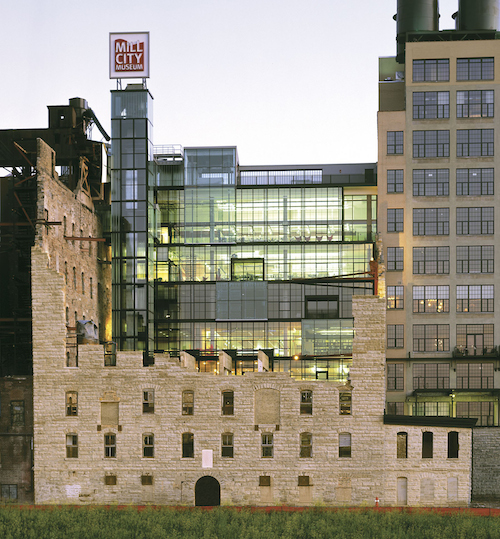Every weekday, as my bus crosses the Missisippi River from St. Paul to Minneapolis, we drive past the the Mill City Museum, with its jigsaw puzzle facade. Other than wondering if that’s what the bombed-out buildings looked like during World War II, I rarely used to give the old brick building—complete with the iconic Gold Medal Flour sign—a second thought. It was part of the riverfront landscape. I knew it had been a flour mill, and I knew flour was big business in Minneapolis, but that was the extent of it.
It wasn’t until I visited the old flour mill recently that I realized just how big a deal that old mill really was. I learned that the seven-story Washburn A Mill was built in 1874, and just four years later, a flour dust explosion (yes, that’s a real thing) completely leveled the mill and killed 14 workers. The fire spread to the adjacent Diamond and Humboldt mills, which also exploded, killing four more workers. It became known as the “Great Mill Disaster.”
The mill was rebuilt and reopened in 1880 as the largest mill in the world, until Pillsbury—built right across the river in the Saint Anthony Main area—stole the title a year later. According to bigboytravel.com, “Washburn’s biggest break in the flour industry probably came at the first International Millers’ Exhibition in 1880. The company had just perfected their flour … they entered and won the gold, silver and bronze medals. This victory truly established their company with world-wide exposure. Their Gold Medal flour is still the No. 1 flour in the United States.
The company continued to consolidate with other mills and became the Minnesota Milling Company. In 1928, the Minnesota Milling Company joined with other mills to form General Mills, which is still one of the biggest grain companies in the world.” The mill hit its peak of production during World War I, and continued to operate until 1965, when technology was no longer dependent on water power and the local milling industry underwent a decline.
The big abandoned building became a popular place for homeless people in the 80s, and in 1991, a massive fire reduced the mill to ruins. (You won’t see machinery/manufacturing gear or the detailed workings of the mill because of this fire.) In 2003, the Minnesota Historical Society opened Mill City Museum in the unique space, used today as a museum and a memorable wedding venue.

I wasn’t really sure what to expect of the old burned-down flour mill, but was excited to check it out. We purchased our tickets and started on the first floor of the gallery, home to the interactive exhibits. The kids made a bee-line to the “Water Lab” area. It was like there was a magnetic pull to the one spot that could get them dirty and/or wet. (How do they do that?!)
The point of the exhibit was to show how waterpower—or hydraulic power—from St. Anthony Falls put Minneapolis on the map as not only a massive timber hub, floating those logs down the Mississippi, but as the flour milling capital. In the late 1800s, the mill ground enough flour to make 12 million loaves of bread a day. That’s a heck of a lot of sandwiches.
I found the displays really interesting—lots of photos and easy-to-digest info, and my kids and their cousin (5, 8, and 8) thought it was really, really, really fun to play in the water. I honestly think they would have stayed in there all day if we had let them. (We may or may not have had to let them walk around in t-shirts because they got their sweatshirts soaking wet.) There was also a train track display for kids, appealing to the Thomas set. I thought that was a nice touch, too.
I admired the giant panoramic wheat field painting and the sculptures (a giant box of Bisquick!) before we boarded the freight elevator for our assigned Flour Tower time slot. We sat down with other families in a sort of theater-like layout, with seats for 30, before the freight door shut and our tour guide explained what we were going to see.
I thought the narrated “Flour Tower” was the best part of the museum. We stopped on various floors and the door opened to give us a sort of replicated tour of the building, with various illuminated displays, video sequences (workers talked about getting “goo balls” of dough in their hair, or how proud they were to have a job at the mill). Once we got to the eighth floor, we went to an observation deck for views of the river, the city, and the luxury condos next door. Those views are worth millions!
We missed the movie about the flour mill explosion, but I was ok with that—by the time we had played downstairs, rode the freight elevator, admired the views, checked out the baking lab, and shopped in the museum store, we were ready for lunch. Not seeing the movie just gives me an excuse to return on another date.
The museum is open Tuesday through Saturday, 10 a.m. to 5 p.m., and Sunday noon to 5 p.m. Admission is $12 for adults, $10 for seniors (65+), $6 for kids 5-17, and free for those 4 and under. For more information, visit millcitymuseum.org.






